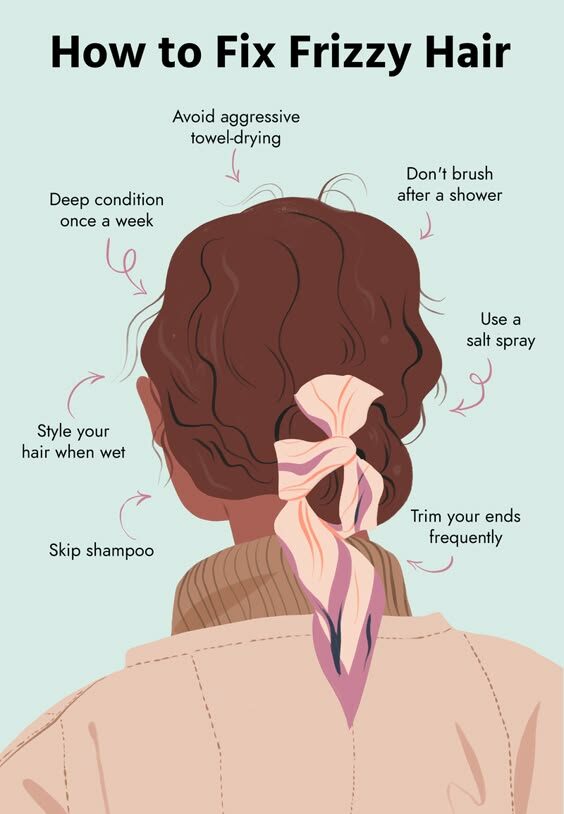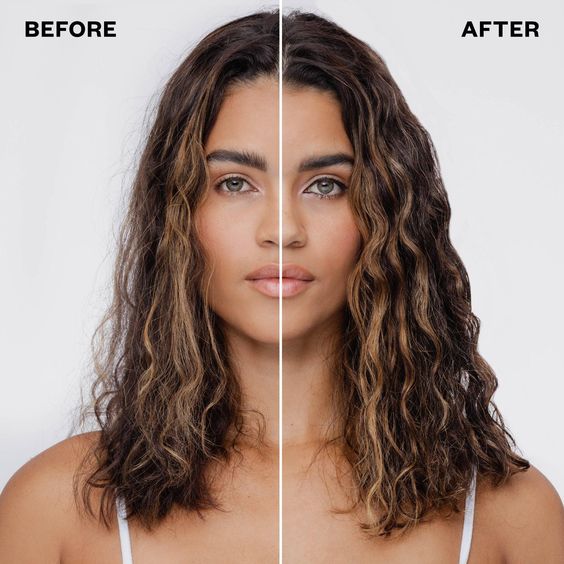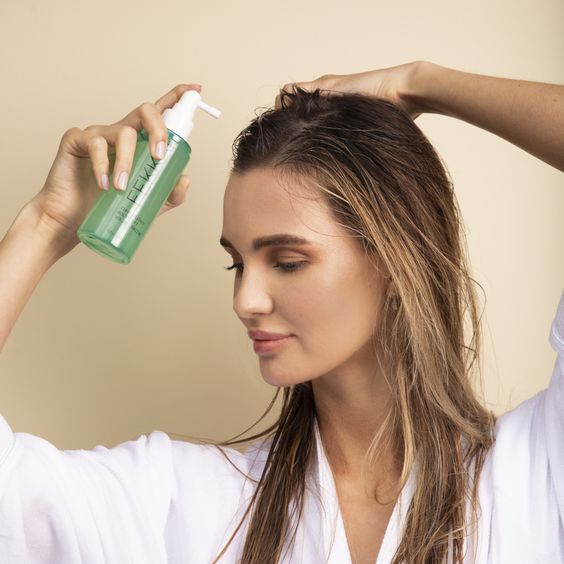Frizzy hair can be a challenge to manage, but with the right routine and products, it’s possible to keep your locks smooth, healthy, and manageable. This comprehensive guide offers practical tips on how to maintain frizzy hair, featuring high-conversion, long-tail, and LSI keywords to ensure SEO optimization while delivering valuable information for your hair care routine.
Understanding Frizzy Hair
Frizz occurs when the hair’s cuticle layer becomes lifted, allowing moisture from the air to penetrate the strands. This leads to swelling and frizz, especially in humid conditions. While frizz is a common issue for those with curly, wavy, or damaged hair, all hair types can experience frizz depending on environmental factors, the hair’s moisture levels, and the quality of the hair cuticle.

Factors like humidity, lack of moisture, and damage from heat styling or chemical treatments often worsen the appearance of frizz. Understanding the root cause of frizz is the first step to managing it effectively. A well-curated hair care routine can significantly reduce frizz and improve overall hair texture.
The Science Behind Frizzy Hair
Frizz often occurs due to the disruption of the hair’s outermost layer, the cuticle. When the cuticle is smooth and lies flat, hair appears sleek and shiny. However, when the cuticle is raised or damaged, moisture enters the hair shaft, causing it to swell and frizz.
Environmental factors like humidity can amplify this effect, but dryness and damage also contribute. If your hair is porous, meaning it absorbs moisture easily, you are more prone to frizz. Heat-styling tools and chemical treatments like bleaching can exacerbate this issue by breaking down the cuticle, leaving your hair vulnerable to frizz.
Daily Hair Care Routine for Frizzy Hair
A well-balanced daily routine is key to preventing and controlling frizz. Start with a sulfate-free shampoo and conditioner that provides hydration. Sulfates can strip the hair of its natural oils, leaving it dry and more prone to frizz. Look for ingredients like glycerin, argan oil, and shea butter that lock in moisture and keep the cuticle smooth.

After washing, gently blot your hair dry with a microfiber towel or a cotton t-shirt to minimize friction and reduce the risk of frizz. Avoid rough towel drying, as this can lift the cuticle and make frizz worse. Apply a leave-in conditioner or an anti-frizz serum while your hair is still damp to help seal in moisture and provide a barrier against humidity.
For added moisture, lightweight oils like argan or coconut oil can be applied to the ends of your hair. These oils not only hydrate but also create a protective layer that prevents moisture from the environment from causing frizz.
Best Shampoos and Conditioners for Frizzy Hair
When selecting products for frizzy hair, opt for sulfate-free shampoos and moisturizing conditioners. Ingredients such as shea butter, coconut oil, glycerin, and argan oil can help smooth the cuticle and lock in hydration. Some great products to consider include:
- Sulfate-Free Moisturizing Shampoos: These prevent excessive drying of the scalp and hair while cleansing.
- Hydrating Conditioners: Choose products with moisture-boosting ingredients like shea butter or glycerin to nourish the hair and reduce frizz.
Leave-In Conditioners and Serums
Leave-in conditioners play a vital role in managing frizzy hair, as they continue to hydrate and protect the hair throughout the day. Look for silicone-free, lightweight formulas to avoid buildup, which can make frizz more pronounced. Anti-frizz serums with silicones or oils, like argan oil, can also provide a smoothing effect while sealing in moisture.

Weekly Treatments: Deep Conditioning and Hair Masks
Deep conditioning is an essential step for anyone dealing with frizzy hair. Once a week, apply a deep conditioner or hair mask that restores moisture and strengthens the hair shaft. These treatments provide extra hydration, which helps to smooth the cuticle and reduce the appearance of frizz. For an added boost, use a heat cap or a warm towel to help the conditioner penetrate the hair more effectively.
How to Choose the Right Deep Conditioner
Look for deep conditioners that are rich in emollients and hydrating agents. Key ingredients to look for include:
- Shea butter: Known for its hydrating and nourishing properties.
- Argan oil: Adds moisture and shine while smoothing the hair.
- Protein treatments: Help rebuild and strengthen damaged hair, reducing the likelihood of frizz caused by breakage.
DIY Hair Masks for Frizz Control
If you prefer a natural approach, DIY hair masks can be a great solution. Ingredients like avocado, honey, and coconut oil are deeply moisturizing and can help reduce frizz. For example, a simple avocado and honey mask can provide intense hydration while sealing the cuticle to prevent frizz.
Protecting Your Hair from Humidity and Heat
Frizz often becomes worse in humid environments, as moisture from the air causes the hair to swell. Protect your hair by applying a heat protectant spray before using any heat styling tools. Heat can damage the cuticle and increase the chances of frizz, so minimizing heat exposure is critical.
Heat-Free Styling Techniques
When possible, opt for heat-free styling techniques that won’t damage your hair or exacerbate frizz. Air drying your hair, using twist-outs, or braiding can all reduce heat exposure while giving your hair a stylish finish. Protective styles, such as buns or loose braids, can also minimize frizz by keeping the hair contained.
Anti-Frizz Products for Humid Weather
For those living in humid climates, anti-frizz products designed for humidity can be lifesavers. Look for humidity-resistant sprays and creams that help keep your hair smooth, even in the dampest conditions. These products create a barrier that prevents moisture from entering the hair shaft.

Nighttime Care to Prevent Frizz
Your hair care routine shouldn’t end at bedtime. Sleeping on a silk or satin pillowcase can make a huge difference in preventing frizz. Unlike cotton, silk and satin create less friction, keeping your hair smooth throughout the night. You can also wrap your hair in a silk or satin scarf to protect it from friction and prevent frizz.
Best Hairstyles for Sleeping
If you have long hair, consider protective hairstyles like loose braids, buns, or twists. These styles reduce friction and keep your hair smooth as you sleep. Avoid tight hairstyles, as these can cause breakage and increase the likelihood of frizz.
Silk Pillowcases and Hair Wraps
Silk and satin pillowcases or hair wraps help prevent frizz by reducing friction between your hair and the pillow while you sleep. The smooth surface of silk allows hair to glide, preventing the tangling and cuticle disruption that leads to frizz.
Adjusting Your Routine for Seasonal Changes
Weather plays a significant role in how your hair behaves. In the winter, frizzy hair may become drier due to cold temperatures and indoor heating, while in the summer, humidity can cause frizz to spike. Adapting your hair care routine to these seasonal changes is key to keeping frizz under control.
Winter Hair Care for Frizzy Hair
In the winter, focus on deep hydration. Use heavier creams and oils to protect your hair from the dry air and prevent static frizz. You might also need to increase the frequency of your deep conditioning treatments to combat the drying effects of cold weather.

Summer Frizz Control
In the summer, humidity becomes the primary concern. Use lightweight products that fight frizz without weighing down your hair. A good anti-humidity spray can create a barrier between your hair and the moist air, keeping your locks smooth even in hot, humid conditions.
Conclusion: Embrace Your Natural Texture
Frizz is a common concern, but with the right routine, you can manage it effectively. The key is to focus on moisture retention, protective styles, and high-quality products designed to smooth the cuticle and keep your hair hydrated. Above all, embrace your natural texture and work with it, not against it. With patience and the right care, frizzy hair can be manageable, healthy, and beautiful.
FAQ Section
1. What causes frizzy hair?
Frizzy hair occurs when the hair cuticle is raised, allowing moisture to enter the hair shaft, causing it to swell and become frizzy. Humidity, heat damage, and lack of moisture are common causes.
2. Can frizz be permanently eliminated?
Frizz can be managed with the right hair care routine, but since frizz is often a natural part of certain hair types, permanent elimination is unlikely. Consistent care will help reduce frizz significantly.
3. What ingredients are best for controlling frizz?
Look for moisturizing ingredients like argan oil, shea butter, glycerin, and silicone-free conditioners. These ingredients help smooth the hair cuticle and retain moisture.
4. Is it possible to reduce frizz without heat?
Yes, heat-free styling techniques such as air-drying, twist-outs, and protective hairstyles can help reduce frizz without the need for heat styling tools.

My name is Nichelle, a beauty blogger with a passion for sharing knowledge and experience in beauty, especially hair care. I am currently collaborating with KS Hair Studio to bring you truly high-quality content such as sharing knowledge, product reviews, and my own hair care journey. Follow Nichellex and KS Hair Studio to discover hair care secrets together!
